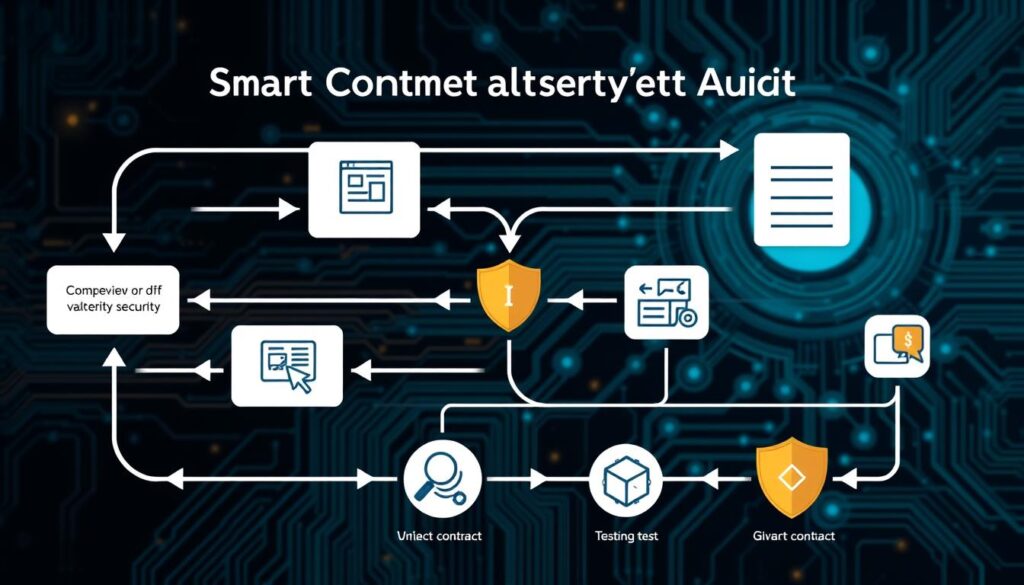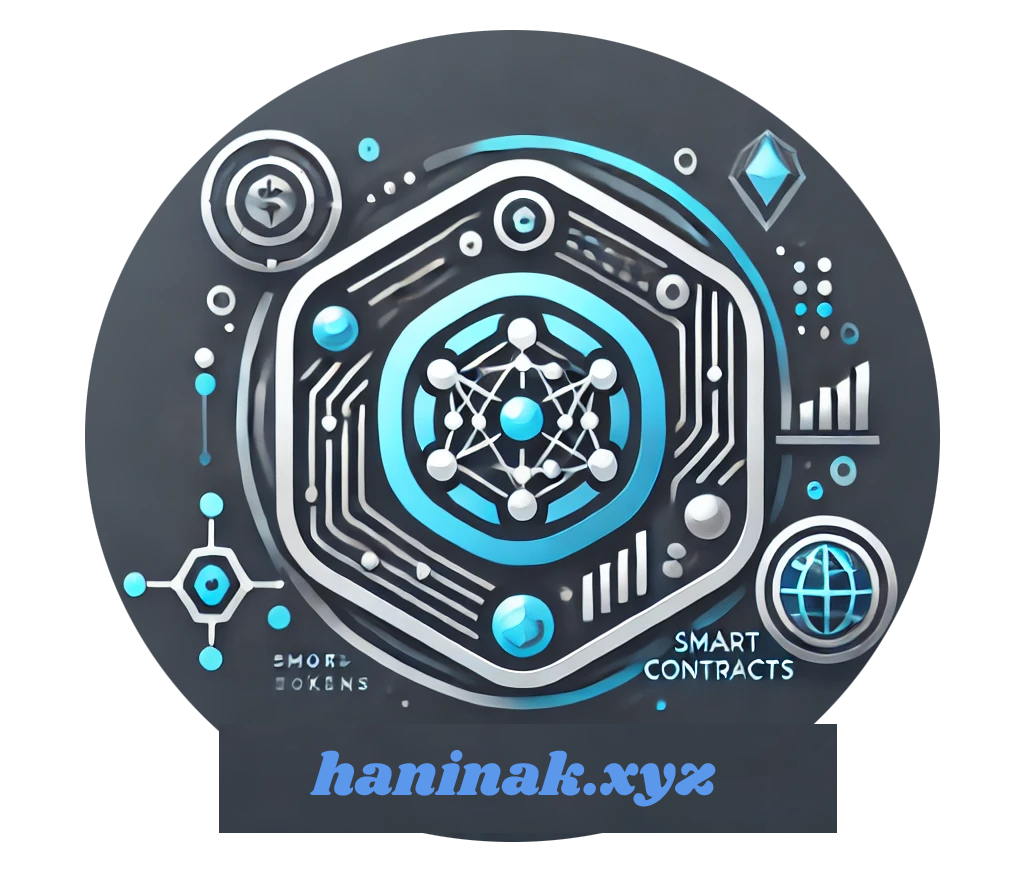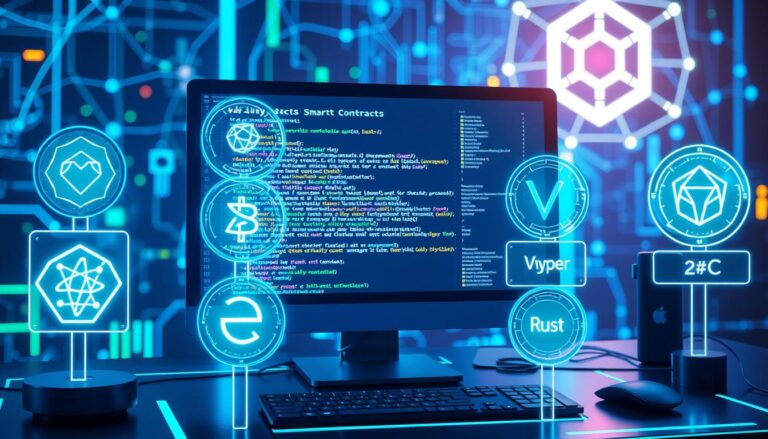How are security audits performed on smart contracts?
In the fast-growing Decentralized Finance (DeFi) world, security audits are key to keeping Smart Contracts safe. By February 20, 2023, DeFi hacks had cost a huge $5.13 billion. This shows how vital it is to protect Blockchain-based DApps with strong security.
Smart contract audits check the code line by line for weaknesses and bugs. Experts, known as smart contract auditors, use their deep knowledge of Ethereum and Solidity. They aim to find and fix security issues, making DApps safer and more reliable.
The audit process includes automated tests, manual code checks, and detailed reports. Auditors use tools and their skills to make sure the code is correct and efficient. This ensures the smart contract works well without problems.
Investing in smart contract audits boosts trust in DeFi projects. It helps avoid expensive hacks and keeps DApps running smoothly. As DeFi grows, so will the need for these audits, making them essential in Web3.
Understanding Smart Contract Security Audits Fundamentals
Smart contract audits are key in the world of decentralized apps and blockchain. Experts analyze the code using both automated and manual methods. They aim to find vulnerabilities, improve code, and ensure the app’s security.
Definition and Core Components
A smart contract security audit checks a contract’s code for security risks. It includes several main parts:
- Documentation review: Experts look at the project’s documents to understand its purpose and how it works.
- Automated testing: Tools quickly scan the code for known problems.
- Manual code review: Security experts examine the code line by line to find complex issues.
- Vulnerability classification: They sort and rank the found problems based on their severity.
The Importance of Smart Contract Auditing
Smart contract audits are vital for secure decentralized apps on Hyperledger Fabric, Distributed Ledgers, and Consensus Mechanisms. They help find and fix problems early, making users trust the app more. Audits also give a fair look at the contract’s security and how well it works.
Security Audit Process Overview
The audit process has several steps. It starts with reviewing documents, then automated testing, followed by manual code checks. Finally, they classify the found issues. This detailed method makes sure the contract is safe before it’s used.

Smart Contracts Technology: Key Vulnerabilities and Risks
Smart contracts, powered by blockchain, have changed how we make digital deals. But, these systems are complex and have many vulnerabilities. These risks can be big if not handled right.
One major risk is the reentrancy attack. It happens when a contract calls another contract, letting the attacker keep calling it. This can empty a contract’s funds, like in the DAO hack in 2016, where $60 million in Ether was lost.
Integer overflow and underflow are also big problems. They happen when math operations go beyond what an integer can handle. This can cause unexpected issues and financial losses. For example, the Beanstalk Farms Attack lost $182 million because of an integer underflow.
- Frontrunning lets bad actors see and use transactions before they’re done. This is a big risk for smart contracts.
- Oracles, which give data to smart contracts, can be hacked. This can mess up the contract’s logic and cause big problems.
- Wrong Token Standards can lead to replay attacks. These attacks can steal funds by duplicating transactions.
These risks can cause huge financial losses and hurt trust in Ethereum. To fix these problems, we need to improve smart contract security. This means doing thorough checks, testing, and using strong fixes.

By knowing the main risks in smart contracts and using good security, developers can make safer blockchain apps. This will help Ethereum and its Solidity-based smart contracts grow and succeed.
Comprehensive Audit Process Steps
Securing blockchain apps, like DApps on Hyperledger Fabric or Ethereum, needs a detailed audit. This ensures smart contracts are safe and work right. Smart contracts are key to these blockchain systems.
Documentation Collection and Review
The audit starts with a deep look at the project’s documents. We check the code, whitepaper, and design to understand the system. This step is key for the next phases of testing and analysis.
Automated Testing Implementation
Next, we use automated testing to check the smart contract. Special tools test its behavior in all possible states. This finds issues or weaknesses. Automated testing is important for catching bugs that might be hard to find by hand.
Manual Code Review Techniques
While automated testing runs, security experts review the code manually. They look at each line for security problems or errors. This step is crucial for finding complex issues that tools might miss.
Vulnerability Classification Methods
Then, we sort out any found vulnerabilities by how serious they are. We use a system with levels like critical, major, and minor. This helps focus on fixing the most important problems first.
The audit ends with a report, followed by fixing issues and a final report. This thorough method is essential for keeping blockchain systems secure and reliable.
Tools and Technologies for Smart Contract Auditing
Smart contracts are key to decentralized apps on blockchain platforms like Ethereum, Polkadot, and Cardano. They are crucial for the success of the Distributed Ledgers, Consensus Mechanisms, and Oracles ecosystem. Auditing smart contract code is vital to avoid financial losses and security breaches.
Specialized tools and technologies have been developed for auditing. Tools like MythX, Slither, and Manticore can quickly find common vulnerabilities. These include reentrancy, integer overflow/underflow, and unrestricted access.
While automated tools are fast and efficient, manual reviews by experts are also essential. They can spot complex issues missed by automated tools. A mix of both automated and manual audits is now common. This approach offers a thorough check of smart contract security.
| Tool | Key Features | Strengths |
|---|---|---|
| MythX | Cloud-based static analysis, taint analysis, fuzzing, symbolic execution | Widely adopted in the Ethereum development community, offers multiple analysis techniques |
| Slither | Fast analysis with an average test execution time of less than a second per contract | Efficient and scalable, can identify a wide range of vulnerabilities |
| Manticore | Symbolic execution, taint analysis, and fuzzing for vulnerability detection | Specializes in identifying complex issues, can handle advanced EVM behavior |
There are also continuous monitoring solutions for ongoing security checks. These tools help detect new vulnerabilities after deployment. They are crucial for contracts that may change or update.
The tools for auditing smart contracts are getting better. They focus on more automation, better integration with development, and stronger security and compliance. This is as the Distributed Ledgers, Consensus Mechanisms, and Oracles ecosystem grows.
Conclusion
Smart contract security audits are key to keeping decentralized apps safe. They check the code, find problems, and fix them. This makes smart contracts and the blockchain world more secure.
Even though audits can’t make code perfect, they help a lot. They lower the risks of using smart contracts. It’s important to keep checking and fixing to keep apps safe as blockchain tech gets better.
As more people use Smart Contracts Technology, security will be even more important. By focusing on detailed audits and staying alert to new threats, developers can keep apps safe and reliable for everyone.







